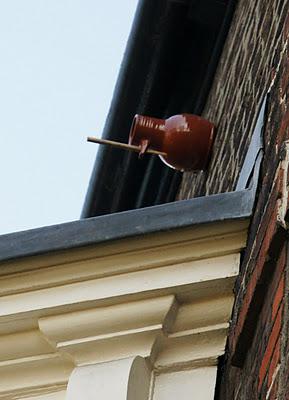 The mystery object on the front of Hogarth's House is a bird pot or 'sparrow pot'. These ceramic, bottle-shaped objects were designed for birds to nest in and seem to have been popular throughout London in the eighteenth century (and for several centuries before). However, their exact purpose is uncertain.
The mystery object on the front of Hogarth's House is a bird pot or 'sparrow pot'. These ceramic, bottle-shaped objects were designed for birds to nest in and seem to have been popular throughout London in the eighteenth century (and for several centuries before). However, their exact purpose is uncertain.A similar pot has been found in Williamsburg, USA; you can buy a replica from the Colonial Williamsburg catalogue, which assumes that the birds were welcomed in order to control insects. However, that doesn't seem to be quite such a convincing explanation for urban London. Why, then, were city-dwellers eager to attract small birds to nest outside their windows?
The likeliest explanation seems to be that the eggs and baby birds were readily accessible (by reaching out of a window and unhooking the bottle) so that they could be taken and eaten. This rather grisly explanation does raise a question: were the tiny amounts of protein worth the effort? I also though that birds would soon learn not to nest in these 'bottles' if they wanted their young to survive, but apparently they are more likely to respond by laying another clutch of eggs.
It will be interesting to find out how the bird pot on Hogarth's House fares. I should add that the staff have no plans to eat any birds nesting there!

